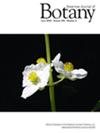Plastomic studies inform the mechanisms of edaphic adaptation in North American species in the tribe Thelypodieae (Brassicaceae)
Abstract
Premise
Adaptation to edaphic environments is vital for plant survival. The tribe Thelypodieae (Brassicaceae) thrives in diverse edaphic conditions, including harsh serpentine soils. A robust phylogeny is essential to understanding the edaphic evolution in this tribe but is challenging to obtain due to incomplete lineage sorting, hybridization, and gene duplication. This study uses organellar and nuclear genome analyses to provide new phylogenetic insights into Thelypodieae, supporting future research on edaphic adaptation.
Methods
We conducted phylogenomic analyses of 28 representative species within the tribe Thelypodieae from western North America and reconstructed phylogenies using plastid, mitochondrial, and selected nuclear loci. Additionally, using the maximum likelihood method CodeML, we identified potential targets of positive selection within the plastid genome.
Results
We obtained a well-resolved phylogenetic tree of the representative species using the complete organellar genomes. Incongruence between organellar and nuclear phylogenies uncovered a history of hybridization within this group. The time-calibrated evolutionary model indicates that Thelypodieae evolved through hybridization and adaptive radiation, driven by climatic and topographic changes since the Miocene. Through comparisons of plastid genomes, we identified specific plastid genes (atpB, ndhC, ndhF, cemA, rps3, rbcL, ycf2, clp1, and matK) that displayed evidence of adaptive evolution, potentially in response to edaphic and climatic challenges.
Conclusions
Through a multigenomic approach, we obtained novel insights into the evolutionary dynamics and adaptive mechanisms in the tribe Thelypodieae that contribute to a clearer understanding of the mechanisms of evolution in a clade of plants that shows adaptation to a range of environments.


 求助内容:
求助内容: 应助结果提醒方式:
应助结果提醒方式:


